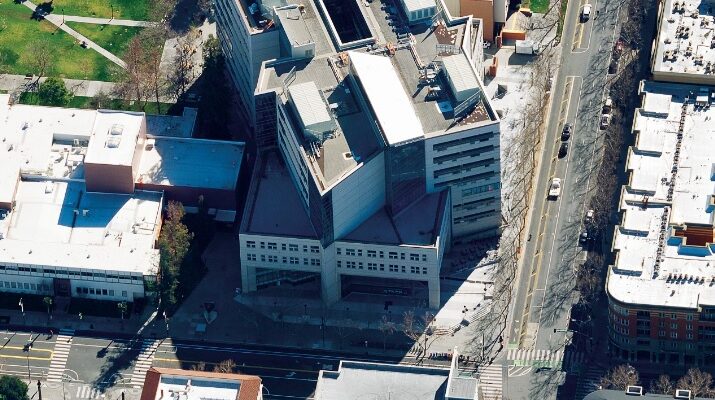Sanborn Relies on Vexcel Osprey Systems to Meet Growing Demands for Oblique Imagery
In response to growing demand for oblique aerial imagery in the vegetation management, tax assessment, and 3D GIS markets, the Sanborn Map Company purchased two Vexcel UltraCam Osprey systems to better serve those applications. The Colorado Springs company replaced its existing oblique system with the large format Osprey M3p, primarily for its four-band nadir camera and wide-area coverage.
“Most oblique systems capture only the Red, Green, and Blue bands, but the Osprey also acquires the Near-Infrared with its photogrammetric nadir camera, which means we can provide much more information for vegetation management applications,” said Sanborn CEO John Copple.
Periodic mapping of vegetation growth in electric transmission corridors is a major part of Sanborn’s oblique imaging business as energy utilities take steps to avoid wildfires touched off by trees contacting powerlines. Sanborn collects three-inch resolution imagery or better for utility customers to evaluate vegetation near power lines. In addition, the Near-Infrared data helps determine vegetative health, so that dead or dying trees can be removed.
An equally important and growing application is in tax assessment where local governments rely on Sanborn’s oblique imagery to find and measure changes to structures and properties –such as room additions, pools, and decks –that alter their taxable value. The combination of oblique and nadir data at resolutions down to one inch gives these customers an information-rich view of every property from all perspectives, explained Copple.
The Era of Digital Twins
While Sanborn expects significant growth in the utility and assessment markets, the oblique imagery application that could eclipse them all is Digital Twins. The Osprey is ideal for making large-area, high-accuracy 3D models, or Digital Twins, of entire cities in a cost-effective manner. The availability of sophisticated, yet affordable, 3D processing software has been a contributing factor as well.
“Before the Osprey and 3D software, the cost to build a Digital Twin was very high,” said Copple. “But thanks to the width of the CCD array in the camera, we collect more data in fewer flight lines –which makes acquisition more cost effective. And we don’t need to supplement the imagery with LiDAR [due to the Osprey’s spatial resolution].”The market for Digital Twins will expand significantly, predicted Copple, driven in large part by the new 3D model capabilities in the Esri ArcGIS package. This functionality makes it possible to turn any GIS into a fully immersive 3D environment, enabling users to view and interact with building structures, natural objects, utility assets, and every other GIS feature in three dimensions.
“Smart Cities, simulations, asset management, emergency response –all applications become infinitely better in 3D,” said Copple. “Information content goes way up when GIS data is overlaid on a 3D model.”
Seamless Integration
The decision to buy the Osprey system was an easy one for the geospatial solutions provider when it decided to expand its oblique business. In terms of maintenance and operations, the Sanborn technical team was already intimately familiar with the Osprey hardware because it operates similarly to the Vexcel UltraCam Eagle, which the firm had been operating for years.
Another advantage of the system was the seamless integration of the Osprey UltraMap software developed to process oblique data sets. Sanborn integrated this software at the front end of its custom production workflow to perform initial image processing, quality control, aero-triangulation, and orthorectification.
Company Profile: Developing cutting-edge digital aerial cameras and photogrammetric processing software with constant product upgrades and world-class support has made Vexcel Imaging a market leader in the geospatial industry. The broadUltraCamaerial camera portfolio covers all applications in airborne photogrammetry —from nadir to oblique to wide-area data collection.
The UltraCam Osprey 4.1, already in the 4th camera generation, is taking flight collection efficiency at superior radiometric and geometric quality to new heights. This highly versatile large-format aerial camera is a two-in-one camera system, that collects photogrammetry-grade nadir and oblique images simultaneously. It meets diverse application needs ranging from 3D mapping to traditional mapping applications from the same flight mission.
Processing of the UltraCam data is handled by the UltraMap photogrammetric software suite that offers an end-to-end processing workflow for highly automated for quality data products that include point clouds, DSMs, DTMs, ortho imagery, and 3D-textured TINs. Customers gain the best possible insight and control over their data throughout the entire value chain to create 3D spatial data products that meet the highest photogrammetric standards.
High-resolution aerial imagery is offered through the Vexcel Data Program (VDP). The VDP is a cloud-based imagery service providing high-resolution nadir and oblique aerial imagery and now includes the recently acquired imagery library from Geomni. The VDP powers the Geospatial Insurance Consortium (GIC), an initiative launched by the National Insurance Crime Bureau to serve the insurance industry through geospatial support and best-of-breed data collected annually, as well as to provide first responders with up-to-date aerial coverage in disaster situations.
Contact: Vexcel Imaging, GmbHAnzengrubergasse 88010 Graz, Austria

